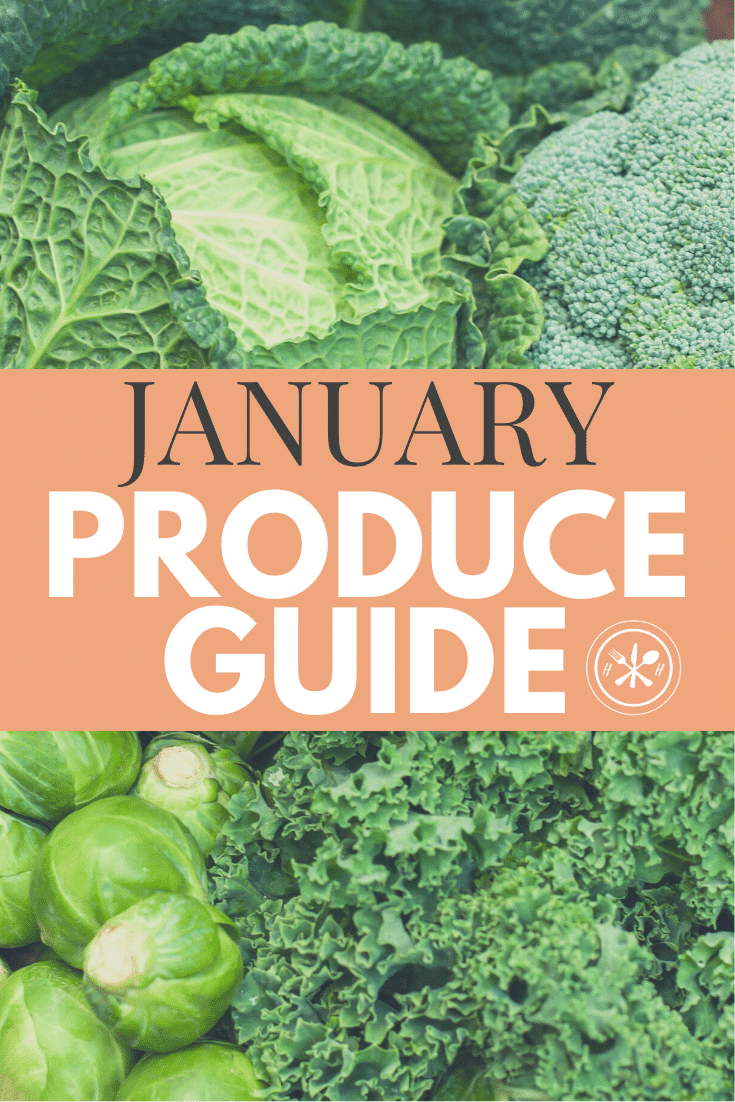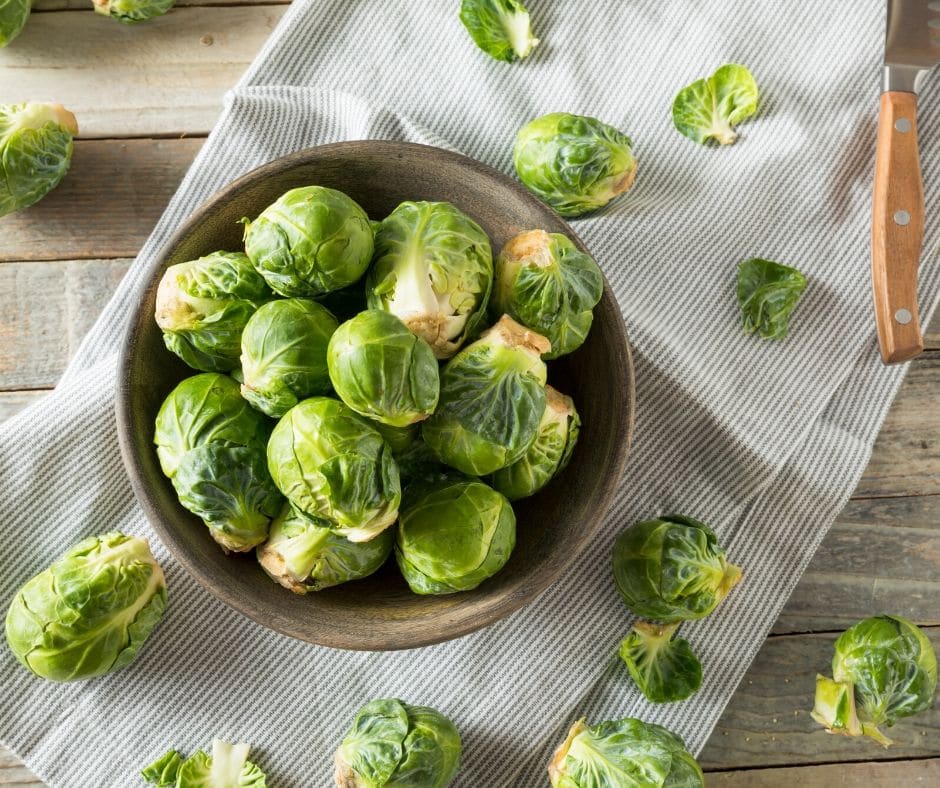Ring in the new year with some gorgeous looking produce! Seasonal produce is more affordable, nutrient-rich, and better tasting. This year, one of my goals is too cut down on grocery expenses by buying in-season produce. Since I'm doing the research anyway, I thought I would share it with you guys!
Of course, what produce is in season can vary by region, so I focused on the Southwest in my research. If you are on the east coast, it should still apply, but some things my vary. I also included recipes you can make with this month's produce, so hopefully, it helps inspire your weekly menu this month!

While we’re entering the coldest month for the growing season, there are still plenty of delicious options to choose from. I’ve included some of my top favorite produce items for January, as well as recipes for each one, so you can be inspired to eat healthfully this month.
Don't forget to also check out December's produce guide, many of the produce items will still be in season this month!
Broccoli
I love broccoli, but I don't love it when my husband says, "WHAT SMELLS LIKE FARTS IN HERE?!?!?"
Unfortunately, the distinct odor of broccoli comes from its high sulfur content. These sulfur-containing compounds are heavily researched for their potential anti-cancer properties. So, even if it smells terrible, you still need to eat it!
Add some crunch and color to your day with broccoli. This vibrant green vegetable is not only pretty to look at, but it’s packed full of fiber, vitamin C, vitamin K, iron, and potassium. It also boasts more protein than other vegetables! With so many health benefits, this vegetable is one that you should take advantage of this month.
Check out some of my favorite recipes featuring broccoli:
- Paleo Beef & Broccoli
- Cedar Plank Salmon, Potatoes, & Broccoli
- Sheet Pan Trader Joe's Cauliflower Gnocchi with Chicken Sausage & Broccoli
- Broccoli Cheddar Oatmeal Bake (with Video)
Click Here For More Broccoli Recipes >>
Brussels Sprouts
While Brussels sprouts may have been your worst enemy as a child, they are certainly an adult staple when it comes to winter cooking. This cruciferous vegetable boasts a high amount of vitamin K and C, both of which are respectively responsible for bone health and immune function, and it also has the best plant source of omega-3 fatty acids. Plus, with so many different ways to use them in the kitchen, you're sure to fall in love with Brussels sprouts in January!
Funny enough I loved Brussel sprouts as a kid, it was summer squash I had a problem with. I loved them steamed with melted butter as a kid. Now I love them just a bit crunchy roasted to a caramelized perfection.
Check out some of my favorite recipes featuring Brussels sprouts:
- Sheet Pan Brats, Sweet Potato, & Brussels Sprouts
- Sautéed Sweet Apple Chicken Sausage & Brussels Sprouts
- Brussel Sprouts & Bacon Chickpea Pasta
Click Here For More Brussel Sprouts Recipes >>
Cauliflower
I feel like cauliflower has taken over everything, so much so that I'm tempted to abbreviate it CF. I mean, pizza crust and rice are fine, but stay out of my crackers, oatmeal, and dessert, okay CF?
You really can dive into the crisp flavors of winter thanks to the beautiful cauliflower, though. This cruciferous vegetable has a high amount of fiber (which is great for satiety and gut health), choline (an essential nutrient for a healthy liver), and sulforaphane (an antioxidant to be protective against colon and prostate cancer). You can also use cauliflower as an alternative to carbohydrates to help boost vegetable intake in your diet. Win-win!
Check out some of my favorite recipes featuring cauliflower:
- Cauliflower Pizza Casserole
- Broccoli and Cauliflower Rice Quiche
- Paleo Cauliflower Rice Crusted Frittata
Click Here For More Cauliflower Recipes >>
Kale
Aka the one vegetable I despise.
Unfortunately for me, it's a super veggie, filled with vitamins K, A, and C, antioxidants, and cancer-fighting substances, this is one cruciferous vegetable that almost has it all. This leafy green is also extremely versatile in the kitchen; from smoothies to soups and skillets to juices, you can add this to pretty much anything for added health benefits. I've gotten pretty skilled at hiding it in things (yes, like a small child).
Check out some of my favorite recipes (to hide) featuring kale:
Click Here For More Kale Recipes >>
Leeks
I remember my aunt describing how to wash a leek to me for the first time. She said, cut the hard green stems off and cut an x in the base so you can wash it off. I remember thinking, do what in (*&!) the what now? Cooking never came naturally to me, but luckily, it was worth learning.
The next time you’re ready to whip up something in the kitchen, consider using leeks in your recipe. This crunchy, green vegetable is in the same family as garlic, onions, and chives. It provides good sources of manganese, vitamin C, and beta carotene, which are essential for keeping you healthy during the winter season! Give them a try this month and let me know how you like it!
Check out some of my favorite recipes featuring leeks:
- Stove Top or Crock Pot Minestrone (<-- Recipe that she was trying to teach me to make.)
- Healthy Paella
- Leek and Asparagus Frittata
Click Here For More Leek Recipes >>
Lemons
I love and hate having a lemon tree. The ability to get fresh lemons is out of this world. Unfortunately, the season sneaks up on me, and I don't start grabbing them on time, which means there is always more than I can use! Luckily they work as decorations too!
Brighten up your winter days by adding lemons to your kitchen counter! Not only are lemons cheery to look at, but they are packed with vitamin C, which is essential for growth, development, and repair of all body tissues, the formation of collagen, iron absorption of iron; wound healing; and immune defense. With so many great health benefits, this is one citrus fruit that you should take full advantage of this winter season!
Check out some of my favorite recipes featuring lemons:
Click Here For More Lemon Recipes >>
Lettuce
I love all types of lettuce including iceberg, romaine, butter, and more. They ALL provide nutrients, fiber, and water. Lettuce is everywhere this time of year, and thanks to its versatility, it can be used in a variety of ways. From salads to wraps, lettuce leaves will add a cooling crunch to your dishes and provide a burst of hydration due to its high water content.
Plus, it’s rich in fiber, which will help satiate and leave you feeling fuller longer. Also, be sure to thoroughly wash your lettuce, as this vegetable can harbor bacteria and dirt. (Ugh, as we know all too well from all the romaine recalls the last couple of years.)
Check out some of my favorite recipes featuring lettuce:
- Barbecue Pulled Pork Lettuce Wraps with Healthy Coleslaw
- Spicy Asian Chicken Lettuce Wraps
- Meal Prep Steak Burrito Bowls
Click Here For More Lettuce Recipes >>
Oranges
I love oranges, so much that I could eat an unlimited amount. And as a kid, I did, because our street was originally an orchard so oranges were plentiful (just ask the roof rats.) Bring some color into your kitchen this month with vibrant, nutrition-packed oranges!
These little gems are a great way to get in some vitamin C, and they are also portable enough where you can pack them up for an easy snack throughout the day. And here is a pro tip for choosing oranges: look for shiny, dense fruits to determine the ripest and flavorful in the bunch!
Check out some of my favorite recipes featuring oranges:
Click Here For More Orange Recipes >>














Julie says
This is an excellent post!! And I'm so jealous of your lemon tree.
Kelli Shallal MPH RD says
So glad you liked it! I'm going to do one every month this year!